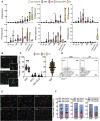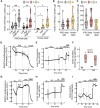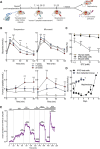In depth functional characterization of human induced pluripotent stem cell-derived beta cells in vitro and in vivo
- PMID: 36060810
- PMCID: PMC9428245
- DOI: 10.3389/fcell.2022.967765
In depth functional characterization of human induced pluripotent stem cell-derived beta cells in vitro and in vivo
Abstract
In vitro differentiation of human induced pluripotent stem cells (iPSCs) into beta cells represents an important cell source for diabetes research. Here, we fully characterized iPSC-derived beta cell function in vitro and in vivo in humanized mice. Using a 7-stage protocol, human iPSCs were differentiated into islet-like aggregates with a yield of insulin-positive beta cells comparable to that of human islets. The last three stages of differentiation were conducted with two different 3D culture systems, rotating suspension or static microwells. In the latter, homogeneously small-sized islet-like aggregates were obtained, while in rotating suspension size was heterogeneous and aggregates often clumped. In vitro function was assessed by glucose-stimulated insulin secretion, NAD(P)H and calcium fluctuations. Stage 7 aggregates slightly increased insulin release in response to glucose in vitro. Aggregates were transplanted under the kidney capsule of NOD-SCID mice to allow for further in vivo beta cell maturation. In transplanted mice, grafts showed glucose-responsiveness and maintained normoglycemia after streptozotocin injection. In situ kidney perfusion assays showed modulation of human insulin secretion in response to different secretagogues. In conclusion, iPSCs differentiated with equal efficiency into beta cells in microwells compared to rotating suspension, but the former had a higher experimental success rate. In vitro differentiation generated aggregates lacking fully mature beta cell function. In vivo, beta cells acquired the functional characteristics typical of human islets. With this technology an unlimited supply of islet-like organoids can be generated from human iPSCs that will be instrumental to study beta cell biology and dysfunction in diabetes.
Keywords: aggregate, beta cell; human induced pluripotent stem cell; insulin secretion; islet; microwell.
Copyright © 2022 Fantuzzi, Toivonen, Schiavo, Chae, Tariq, Sawatani, Pachera, Cai, Vinci, Virgilio, Ladriere, Suleiman, Marchetti, Jonas, Gilon, Eizirik, Igoillo-Esteve and Cnop.
Conflict of interest statement
The authors declare that the research was conducted in the absence of any commercial or financial relationships that could be construed as a potential conflict of interest.
Figures




Similar articles
-
Differentiation and transplantation of functional pancreatic beta cells generated from induced pluripotent stem cells derived from a type 1 diabetes mouse model.Stem Cells Dev. 2012 Sep 20;21(14):2642-55. doi: 10.1089/scd.2011.0665. Epub 2012 Jun 1. Stem Cells Dev. 2012. PMID: 22512788 Free PMC article.
-
Islet-like organoids derived from human pluripotent stem cells efficiently function in the glucose responsiveness in vitro and in vivo.Sci Rep. 2016 Oct 12;6:35145. doi: 10.1038/srep35145. Sci Rep. 2016. PMID: 27731367 Free PMC article.
-
Efficient generation of functional pancreatic β-cells from human induced pluripotent stem cells.J Diabetes. 2017 Feb;9(2):168-179. doi: 10.1111/1753-0407.12400. Epub 2016 May 31. J Diabetes. 2017. PMID: 27038181
-
Islets in the body are never flat: transitioning from two-dimensional (2D) monolayer culture to three-dimensional (3D) spheroid for better efficiency in the generation of functional hPSC-derived pancreatic β cells in vitro.Cell Commun Signal. 2023 Jun 22;21(1):151. doi: 10.1186/s12964-023-01171-8. Cell Commun Signal. 2023. PMID: 37349801 Free PMC article. Review.
-
Lessons from Human Islet Transplantation Inform Stem Cell-Based Approaches in the Treatment of Diabetes.Front Endocrinol (Lausanne). 2021 Mar 11;12:636824. doi: 10.3389/fendo.2021.636824. eCollection 2021. Front Endocrinol (Lausanne). 2021. PMID: 33776933 Free PMC article. Review.
Cited by
-
Differentiation to insulin-positive cells from human amnion epithelial cells using a pancreatic development mimicry protocol.Histochem Cell Biol. 2025 Jul 14;163(1):76. doi: 10.1007/s00418-025-02400-6. Histochem Cell Biol. 2025. PMID: 40658268 Free PMC article.
-
Forward programming of hiPSCs towards beta-like cells using Ngn3, Pdx1, and MafA.Sci Rep. 2024 Jun 13;14(1):13608. doi: 10.1038/s41598-024-64346-4. Sci Rep. 2024. PMID: 38871849 Free PMC article.
-
The N6-methyladenosine RNA epigenetic modification modulates the amplification of coxsackievirus B1 in human pancreatic beta cells.Front Microbiol. 2024 Dec 18;15:1501061. doi: 10.3389/fmicb.2024.1501061. eCollection 2024. Front Microbiol. 2024. PMID: 39744389 Free PMC article.
-
Cell identity dynamics and insight into insulin secretagogues when employing stem cell-derived islets for disease modeling.Front Bioeng Biotechnol. 2024 Jun 12;12:1392575. doi: 10.3389/fbioe.2024.1392575. eCollection 2024. Front Bioeng Biotechnol. 2024. PMID: 38933536 Free PMC article.
-
Epigenetic modulation of cell fate during pancreas development.Trends Dev Biol. 2023;16:1-27. Trends Dev Biol. 2023. PMID: 38873037 Free PMC article.
References
Grants and funding
LinkOut - more resources
Full Text Sources
Other Literature Sources

